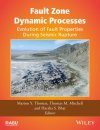About this book
Why do earthquakes happen? What properties control the dynamic rupture and what are the processes at play? Chapters in the present volume capture the current state of the art by displaying an overview of the existing knowledge on the physics of dynamic faulting and promote multidisciplinary contributions on the observational and experimental fault fabric and mechanics, the evolution of fault zone physical and chemical properties, dynamic rupture processes and physically, and observationally, consistent numerical modeling of fault zone during seismic rupture.
Fault Zone Dynamic Processes examines questions such as:
- What are the dynamics processes recorded in fault gouge?
- What can we learn on rupture dynamic from laboratory experiments?
- How on-fault and off-fault properties affect seismic ruptures? How do they evolve trough time?
- Insights from physically, and observationally, consistent numerical modeling
Fault Zone Dynamic Processes: Evolution of Fault Properties During Seismic Rupture is a valuable contribution for Earth's scientists, researchers and students interested in the earthquakes processes and properties of on-fault and off-fault zones. Its multidisciplinary content is relevant to a broad audience: structural geologist, experimentalists, rocks mechanicians, seismologist, geophysicists and modellers.
Contents
Fault Zone Dynamic Processes: Evolution of Fault Properties During Seismic Rupture (preface)
Marion Y. Thomas; Thomas Mitchell and Harsha S. Bhat
Part I: Structural Evidences of Coseismic Slip
1) Incipient pulverization at shallow burial depths along the San Jacinto Fault, southern California
James Whearty, Thomas Rockwell and Gary Girty
2) Earthquake parameters deduced from a Pliocene-Pleistocene pseudotachylyte in Eastern Taiwan
Caitlyn Korren, Eric Ferre, En-Chao Yeh, Yu-Min Chou and Hao-Tsu Chu
3) Fluid inclusion evidence of co-seismic fluid flow induced by dynamic rupture
Thomas Mitchell, Jose Cembrano, Kazuna Fujita, Kenichi Hoshino, Daniel Faulkner, Pamela Perez-Flores, Gloria Arancibia, Marieke Rempe and Rodrigo Gomila
4) Coseismic damage generation and pulverization in fault zones: insights from high strain rate experiments
Franciscus Aben, Mai-Linh Doan, Jean-Pierre Gratier and Francois Renard
5) “Coseismic foliations” in gouge and cataclasite: experimental observations and consequences for interpreting the fault rock record
Steven Smith, James Griffiths, Michele Fondriest and Giulio Di Toro
Part II: Fault Properties during Dynamic Rupture
6) The transition from frictional sliding to shear melting in laboratory stick-slip experiments
David Lockner, Brian Kilgore, Nicholas Beeler and Diane Moore
7) Powder-rolling as a mechanism of dynamic fault weakening
Xiaofeng Chen, Andrew Elwood Madden and Ze'ev Reches
8) Earthquake source properties from instrumented stick-slip
Brian Kilgore, Art McGarr, Nicholas Beeler and David Lockner
9) Dynamic weakening and the depth dependence of earthquake faulting
Nicolas Brantut and John D. Platt
Part III: Influence of Fault Properties on Coseismic Rupture
10) Scaling of fault roughness and implications for earthquake mechanics
Francois Renard and Thibault Candela
11) Fault branching and long-term earthquake rupture scenario for strike-slip earthquakes
Yann Klinger, Jin-Hyuck Choi and Amaury Vallage
12) Influence of fault strength on precursory processes during laboratory earthquakes
François Passelègue, Soumaya Latour, Alexandre Schubnel, Stefan Nielsen, Harsha S. Bhat and Raul I Madariaga
13) Upper limit on damage zone thickness controlled by seismogenic depth
Jean-Paul Ampuero and Xiaolin Mao
14) Effect of Brittle off-fault Damage on Earthquake Rupture Dynamics
Marion Y. Thomas, Harsha S. Bhat and Yann Klinger
Customer Reviews







































